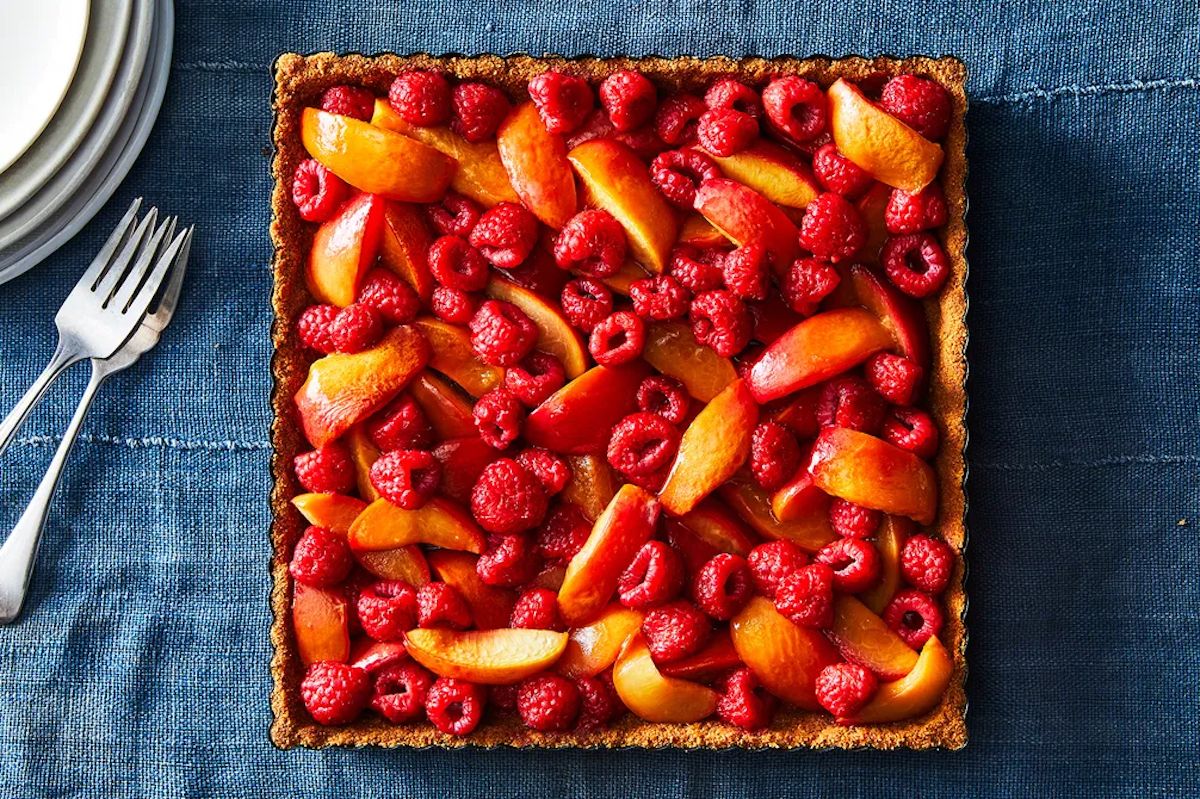Whether you're wandering around in a farmers market or passing through a section of the grocery store, odds are you've seen the term "stone fruit" tossed around near the peaches and plums. You put your keen mind to the task and gather that the term is referencing a fruit (great start) with a, well, stone-like pit. Nailed it! But is there more to the concept? What is a stone fruit, exactly?
What is a stone fruit?
We've already gone over the obvious: Stone fruits are those with pits in the center. Officially, they're fruits with a fleshy exterior known as the mesocarp (covered with a skin, or exocarp) that encases a stone or pit (the shell of which is a hardened endocarp with a seed inside). Also known as drupes, this category includes peaches, plums, cherries, nectarines, apricots, and pluots.
Dates, mangoes, coconuts, green almonds, lychees, and olives are also technically classified as stone fruits, as are mulberries, blackberries, and raspberries. Their peak season is summer, roughly mid-May through mid- to late-August.
Wait, some berries are stone fruits?
Botanically speaking, according to the Encyclopedia Britannica, a berry is a fleshy fruit with multiple seeds, deriving "from a single ovary of an individual flower." This category includes cranberries and blueberries, as well as bananas, grapes, tomatoes, and avocados, among others — but it does not include mulberries, blackberries, and raspberries.
While their name implies they are berries, mulberries, blackberries, and raspberries are actually aggregate fruits in the drupe or stone fruit family. Each mulberry, raspberry, or blackberry is a drupelet, or cluster of tiny drupes, each of which contains a single seed. (Strawberries are also aggregate fruit, but they're achenes, not drupes—a story for another day.)
Can we break down clingstone vs. freestone fruit, too?
You'll typically come across the terms "clingstone" and "freestone" with peaches. Unsurprisingly, they refer to whether the stone, or pit, stubbornly clings to the flesh or can be easily pulled out when the fruit is sliced open. According to the Peach Truck, clingstone peaches, which are in season from mid-May through early June, are great for eating but don't hold up as well to freezing or canning; whereas freestones, available from mid-June to August, are great for anything: "You just slice the peach down the middle and pull it right off the pit."
What's this I hear about poisonous pits?
Technically, there is a dangerous chemical called amygdalin present in the seeds of stone fruits. According to the National Capital Poison Center, "poisoning can occur when the pit and seed are crushed or chewed before swallowing, releasing the amygdalin. Amygdalin is then converted by the body to cyanide." Um, yikes?
Still, the cyanide factor has not stopped several chefs from playing around with the ingredient. Food52 co-founder Amanda Hesser wrote about apricot pit ice cream for The New York Times in 2000, after trying it at Blue Hill in Manhattan. According to Shirley O. Corriher, a biochemist and the author of "Cookwise," whom Hesser interviewed for her piece, "It would take a lot of kernels to harm an adult." If you're interested in trying the recipe, we've got you covered. (Of course, if stone-fruit-pit ice cream isn't your speed, simply eat the fruit flesh.)
***
Recipe: Apricot Pit Ice Cream
Makes: one quart
Ingredients
- 45 to 50 apricot pits (4 1/2 ounces)
- 2 cups milk
- 1 1/2 cups heavy cream
- 1/4 cup plus 3 tablespoons sugar
- 7 egg yolks
Directions
- Wrap apricot pits in a heavy dish towel. On the floor or on a sturdy cutting board, crack pits open using a hammer or a meat mallet, exposing kernels. Watch your fingers.
- In a medium saucepan, combine apricot kernels and shells with milk and heavy cream. Bring to a boil; turn off heat and let cool. Chill overnight in refrigerator.
- The next day, bring the milk mixture to a boil again and strain through a fine sieve. Meanwhile, in a large bowl, whisk together the sugar and the yolks until light and fluffy. Whisk about 1/2 cup hot milk into the egg mixture, and then whisk the egg mixture into the milk. Pour into a large saucepan, place over medium-low heat and, stirring constantly with a wooden spoon, cook until thick enough to coat the back of the spoon. Remove from heat immediately. Let cool, and then strain.
- Pour into an ice cream maker and follow manufacturer's instructions.
Just a few of our favorite (sweet and savory!) stone fruit recipes
Playing Up Perfect Peaches
- Renee Erickson's Peach Cobbler with Hot Sugar Crust
- Peach Tart
- Peach Salad with Anchovy Vinaigrette
- Green Peach and Blue Cheese Toast
Bursting with Pleasant Plums
- Plum Crisp with Toasted Oat Streusel
- Plums and Roses Sorbet
- Tomato and Plum Galette with Black Pepper-Parmesan Crust
- Plums with Burrata and Crunchy Roasted Lentils
Highlighting Cheery Cherries
- Blue Cheese and Cherry Crostatas
- Cherry and Beet Toasts With Ricotta
- Sautéed Cherries with Vanilla Bean
- Paul Kahan's Charred Radicchio With Arugula, Cherries & Parmigiano
Full of Nifty Nectarines
- Prosciutto, Nectarine and Fontina Panini on Rosemary Focaccia
- Melon and Nectarine Shaved Summer Salad
- Tomato, Nectarine and Mozzarella Salad
- Plum-Nectarine Upside-Down Skillet Cake
Packed With Dreamy Dates
- Renee Erickson's Sautéed Dates
- Chewy Date Squares
- Date Banana Bread with Date Jam
- Bittersweet Roasted Radicchio with Ricotta and Dates
Starring Brilliant Blackberries and Radiant Raspberries
- Blackberry Ginger Ale Mojito
- Samantha Seneviratne's Blackberry Cuatro Leches
- Challah Bread Pudding with Raspberries
- Raspberry Habanero Relish
Featuring Magnificent Mangoes


Shares